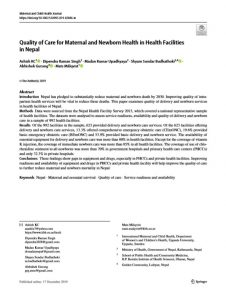
Introduction
Nepal has pledged to substantially reduce maternal and newborn death by 2030. Improving quality of intrapartum health services will be vital to reduce these deaths. This paper examines quality of delivery and newborn services in health facilities of Nepal.
Methods
Data were sourced from the Nepal Health Facility Survey 2015, which covered a national representative sample of health facilities. The datasets were analysed to assess service readiness, availability and quality of delivery and newborn care in a sample of 992 health facilities.
Results
Of the 992 facilities in the sample, 623 provided delivery and newborn care services. Of the 623 facilities offering delivery and newborn care services, 13.3% offered comprehensive emergency obstetric care (CEmONC), 19.6% provided basic emergency obstetric care (BEmONC) and 53.9% provided basic delivery and newborn service. The availability of essential equipment for delivery and newborn care was more than 80% in health facilities. Except for the coverage of vitamin K injection, the coverage of immediate newborn care was more than 85% in all health facilities. The coverage of use of chlorhexidine ointment to all newborns was more than 70% in government hospitals and primary health care centers (PHCCs) and only 32.3% in private hospitals.
Conclusions
These findings show gaps in equipment and drugs, especially in PHCCs and private health facilities. Improving readiness and availability of equipment and drugs in PHCCs and private health facility will help improve the quality of care to further reduce maternal and newborn mortality in Nepal.